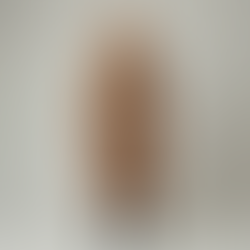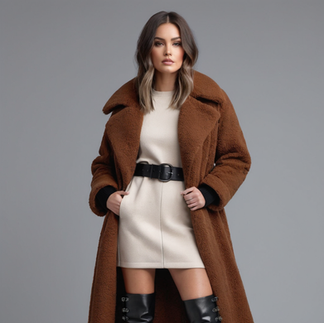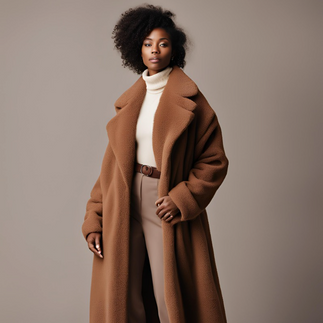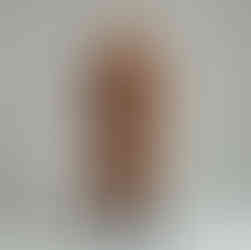Comparing AI Image Generators for the Fashion Industry: The Good, the Bad and the Ugly
- Sep 4, 2024
- 5 min read
Updated: Sep 5, 2024

When we decided to explore AI image generators for fashion, we wanted to see how they perform with a very specific prompt related to a minimalistic fashion portrait of a woman wearing a Teddy coat. While these tools are still evolving, it’s clear that getting involved now is essential for any forward-thinking designer. The results might not always blow you away, but they often reveal fascinating shapes and textures that can spark new ideas in your creative process.

Image: The Fashion Guild®
We tested 7 different AI image generators using this prompt:
A minimalistic fashion portrait featuring a woman standing against a plain, light grey background. She is wearing a monochromatic outfit in warm brown tones, consisting of a belted midi dress and a luxurious, oversized coat made from teddy bear fabric. Her look is completed with black, chunky lace-up combat boots with metal hardware. The overall aesthetic is modern and sophisticated, with a focus on texture and muted, earthy colours. The woman has short, straight blonde hair and a serious, confident expression. This is a high-quality Hasselblad photo taken in a professional studio.The Results
1. Midjourney
Midjourney was a standout in terms of artistic interpretation, realism and 'coolness'. It’s great for creating visually compelling and imaginative images, and while it doesn’t always stick rigidly to prompts (that's an understatement), it often surprises you in creative ways. The interface is now more accessible as a web platform (compared to the original Discord implementation), making it easy to dive in, edit and upscale, even if you’re new to this. It’s not without its quirks, but the balance of creativity and usability makes it a fantastic tool for artistic exploration in fashion design. You’ll find it can push you in unexpected but exciting directions. We love Midjourney!
Images: The Fashion Guild®
2. DALL·E (by OpenAI)
If you’re after more photorealistic results, DALL·E might not be for you. It produces detailed, illustration-like images, and when it does capture photo-realism it can often throw up oddities. Although some finer elements, like hands and faces, still pose a challenge, the results are (more or less) striking. Now, having bitched about it, we wouldn't be fair if we didn't admit that it is a great place to explore ideas—so don't be put off. GPT 4.0 is awesome and it's only a matter of time before they blend the two. Then we'll be cooking!
Images: The Fashion Guild®
3. Flux
The general consensus is that Flux offers the kind of precision that appeals to designers who need control over their creative process. It's more technical than the others, and while it takes some time to get used to, the payoff is big if you’re willing to dive deep. We are not totally sure that we buy-in to that storyline, just yet. Its open-source platform (via HuggingFace) lets you play for free, making it ideal for those looking for photorealistic images that are close to your intended prompt. We found there were some odd things such as bizarre anatomy, but overall we say, "Don't look a gift-horse in the mouth."
Images: The Fashion Guild®
4. Playground AI
Playground AI falls somewhere between the artistic freedom of Midjourney, DALL·E and all of the AI Image Generators who use Stable Diffusion as their base. It offers a variety of styles (actually, loads), but its strength lies in generating fashion visuals quickly and easily. It’s great for early-stage exploration when you’re still figuring out your direction, as it churns out ideas fast, even if they aren’t always perfectly polished. On the downside, it's affinity with Contemporary Fashion seems to be only fleeting. Or as we say in the studio, "It's NASTY!" (and we really do mean Nasty, and not Fabulous). It also struggled to follow the detail of the prompt instructions for example failing to produce short blond hair. Don't be put off though. We use it all the time when we need specific image details.
Images: The Fashion Guild®
5. Canva AI
Canva AI is part of a suite of design tools that most of you are probably familiar with. Its AI image generator isn’t going to produce the most realistic results—it leans more toward a stylised look—but it’s incredibly easy to use. If you’re looking for something to help you generate quick design elements or mock-ups, this is the tool for you. However, if you’re after high-end fashion visuals, you might find it falls short. It's a bit "MEH". Again, this generator also failed to follow some of the prompt detail, such as 'short, straight blonde hair'.
Images: The Fashion Guild®
6. Freepik
Freepik’s AI tools are useful for more straightforward visuals. It’s not as advanced as the others but can be a handy resource when you need simple, stylish content, like textures or backgrounds. It’s not likely to give you the contemporary-fashion vibe on its own, but as part of a broader toolkit, it’s worth a look. Having 'dumped' on Freepik, we actually think it is one to watch. It did give us some good-looking design ideas and we know that their team is working hard to be über-competitive.
Images: The Fashion Guild®
7. NewArc
NewArc.ai is a fantastic tool for designers looking for a quick solution to mock-up their design ideas. What sets it apart is that it can take your pencil sketches and transform them into photorealistic images. This makes it perfect for fashion designers who want to see their designs brought to life with realistic fabrics, textures, and lighting. With reasonable control over details like colours and materials, it’s a great choice if you’re focused on creating realistic visuals rather than abstract interpretations (For advert grade images we have to take them out and put them through photoshop and Freepik image up-scaler). We’ve used it with some of our own sketches, and the results are pretty good—we’re genuinely impressed!
Images: The Fashion Guild®
Adobe Firefly - excluded
We have to confess that we are super disappointed with Adobe Firefly. It rejected our prompt (and variations) and although we clicked the 'For Review' button it still doesn't work and we never heard back from them. So, a big "rasp!" for Adobe. We were therefore unable to include it in our test results.
Why Bother with AI Image Generators?
The key takeaway is this: while AI image generation is still in its early stages, it’s worth getting involved now. Yes, the outputs can be hit or miss, but even the misses can offer interesting insights into silhouettes and textures. As the technology improves, we’re only going to see better, more sophisticated results. For designers, these tools can be game-changers, especially during the research and pre-design phases.
The future of fashion is undeniably digital, and as designers, we need to keep up. Whether you’re testing out creative ideas or refining polished looks, these tools open up new possibilities and save hours of manual work. And while they’re not perfect yet, they’re evolving fast. So, why not start experimenting now?
Let us know your thoughts and experiences with AI in fashion design—we’d love to hear how you're using these tools in your creative process.














































